A Novel Load Extrapolation Method for Multiple Non-Stationary Loads on the Drill Pipe of a Rotary Rig
Abstract
1. Introduction
1.1. Related Works
1.1.1. Approach for Keeping the Load Sequence
1.1.2. Load Extrapolation
1.1.3. Advanced Load Extrapolation Method
1.2. Motivation and Contribution
- Consideration of multiple non-stationary loads. The framework addresses the challenge of multiple non-stationary loads acting simultaneously, allowing for a more realistic representation of load variations.
- Integration of rainflow counting and POT method. By incorporating rainflow counting and the POT method, the framework effectively captures extreme load amplitudes and enables accurate extrapolation of the load spectrum.
- DKDE method for median amplitudes estimation. The DKDE method is employed to fit and extrapolate median amplitudes, providing a reliable estimation of load behavior.
- Comprehensive load spectrum representation. A load spectrum that accounts for both median and extreme load variations, offering a more complete understanding of the load profiles for structural analysis.
2. Methods
2.1. Proposed Load Spectrum Extrapolation Framework
- Data collection and preprocessing. The stress data of the drill pipe are converted into torque and force data, which are filtered and synchronized with rainflow counting to obtain the same mean and amplitude sequences.
- Fit distributions. The amplitude sequence is analyzed by fitting distributions to different parts of the data. Specifically, a GPD fit is applied to the portion beyond a specified threshold, while a DKDE fit is used for the section between the median and the threshold. This fitting process allows for capturing the characteristics and modeling the distribution of amplitudes within different ranges of the data.
- Load extrapolation. To extrapolate the amplitude in the order of occurrence, an inverse cumulative distribution function (ICDF) is established based on the probability density function (PDF) of the distribution function. Using the established ICDF, we can extrapolate the amplitudes in the order of occurrence by generating random numbers from a uniform distribution and mapping them to corresponding amplitude values using the ICDF.
- Generate load spectrum and damage evaluation. The extrapolated amplitude sequence, obtained using the inverse cumulative distribution function, is combined with the original mean sequence to form a load spectrum, and nonlinear damage is used to assess the damage of the current extrapolated load spectrum.
2.2. Data Preprocessing
2.3. Distribution Fitting
2.3.1. Generalized Pareto Distribution Model
2.3.2. Threshold Selection
2.3.3. Diffusion Kernel Density Estimation
2.4. Load Extrapolation
2.5. Damage Evaluation
2.5.1. Equivalent of the Mean Value
2.5.2. Multi-Axis Load Equivalence
2.5.3. Linear/Nonlinear Damage Accumulation Rule
3. Implementation and Results
3.1. Experiments and Data Preprocessing
3.2. Fitting the Distribution of Extremes
3.3. Fitting the Distribution of the Median Amplitude
3.4. Load Extrapolation and Damage Evaluation
4. Conclusions
Author Contributions
Funding
Data Availability Statement
Acknowledgments
Conflicts of Interest
Abbreviations
| CDF | Cumulative Distribution Function |
| ICDF | Inverse Cumulative Distribution Function |
| KDE | Kernel Density Estimation |
| DKDE | Diffusion Kernel Density Estimation |
| Probability Density Function | |
| GPD | Generalized Pareto Distribution |
References
- Lu, X.; Jiang, T. Working Pose Measurement and Quality Evaluation of Rotary Drilling Rig Based on Laser Tracker. Optik 2019, 187, 311–317. [Google Scholar] [CrossRef]
- Wang, J.; Chen, H.; Li, Y.; Wu, Y.; Zhang, Y. A Review of the Extrapolation Method in Load Spectrum Compiling. Stroj. Vestn. J. Mech. Eng. 2016, 62, 60–75. [Google Scholar] [CrossRef]
- Sun, L.; Liu, M.; Wang, Z.; Wang, C.; Luo, F. Research on Load Spectrum Reconstruction Method of Exhaust System Mounting Bracket of a Hybrid Tractor Based on MOPSO-Wavelet Decomposition Technique. Agriculture 2023, 13, 1919. [Google Scholar] [CrossRef]
- Samavatian, V.; Iman-Eini, H.; Avenas, Y. An Efficient Online Time-Temperature-Dependent Creep-Fatigue Rainflow Counting Algorithm. Int. J. Fatigue 2018, 116, 284–292. [Google Scholar] [CrossRef]
- Loew, S.; Bottasso, C.L. Lidar-Assisted Model Predictive Control of Wind Turbine Fatigue via Online Rainflow-Counting Considering Stress History. Wind Energ. Sci. 2021, 7, 1605–1625. [Google Scholar] [CrossRef]
- Obermayr, M.; Riess, C.; Wilde, J. A Novel Online 4-Point Rainflow Counting Algorithm for Power Electronics. Microelectron. Reliab. 2021, 120, 114112. [Google Scholar] [CrossRef]
- Musallam, M.; Johnson, C.M. An Efficient Implementation of the Rainflow Counting Algorithm for Life Consumption Estimation. IEEE Trans. Reliab. 2012, 61, 978–986. [Google Scholar] [CrossRef]
- Twomey, J.M.; Chen, D.Y.; Osterman, M.D.; Pecht, M.G. Development of a Cycle Counting Algorithm with Temporal Parameters. Microelectron. Reliab. 2020, 109, 113652. [Google Scholar] [CrossRef]
- Zhu, Y.; Zhang, S.; Yan, M. A Cycle Counting Method Considering Load Sequence. Int. J. Fatigue 1993, 15, 407–411. [Google Scholar] [CrossRef]
- Jiang, D. A Sequence Retainable Iterative Algorithm for Rainflow Cycle Counting. SAE Int. J. Mater. Manuf. 2014, 7, 108–114. [Google Scholar] [CrossRef]
- Jin, T.; Yan, C.; Guo, J.; Chen, C.; Zhu, D. Compilation of Drilling Load Spectrum Based on the Characteristics of Drilling Force. Int. J. Adv. Manuf. Technol. 2022, 124, 4045–4055. [Google Scholar] [CrossRef]
- Wang, Y. A Novel Method for the Distribution and Extrapolation of Extreme Sea State Parameters. Ocean Eng. 2022, 251, 111102. [Google Scholar] [CrossRef]
- Liu, X.; Wang, H.; Wu, Q.; Wang, Y. Uncertainty-Based Analysis of Random Load Signal and Fatigue Life for Mechanical Structures. Arch. Comput. Methods Eng. 2021, 29, 375–395. [Google Scholar] [CrossRef]
- Johannesson, P. Extrapolation of Load Histories and Spectra. Fatigue Fract. Eng. Mater. Struct. 2006, 29, 209–217. [Google Scholar] [CrossRef]
- Zheng, G.; Liao, Y.; Chen, B.; Zhao, S.; Wei, H. Multi-Axial Load Spectrum Extrapolation Method for Fatigue Durability of Special Vehicles Based on Extreme Value Theory. Int. J. Fatigue 2024, 178, 108014. [Google Scholar] [CrossRef]
- Shangguan, W.B.; Zheng, G.F.; Rakheja, S.; Yin, Z. A method for editing multi-axis load spectrums based on the wavelet transforms. Measurement 2020, 162, 107903. [Google Scholar] [CrossRef]
- Poloni, D.; Oboe, D.; Sbarufatti, C.; Giglio, M. Towards a stochastic inverse Finite Element Method: A Gaussian Process strain extrapolation. Mech. Syst. Signal Process. 2023, 189, 110056. [Google Scholar] [CrossRef]
- Wen, C.K.; Li, R.C.; Zhao, C.J.; Chen, L.P.; Wang, M.H.; Yin, Y.X.; Meng, Z.J. An improved LSTM-based model for identifying high working intensity load segments of the tractor load spectrum. Comput. Electron. Agric. 2023, 210, 107879. [Google Scholar] [CrossRef]
- Lin, P.; Ding, F.; Hu, G.; Li, C.; Xiao, Y.; Tse, K.; Kwok, K.; Kareem, A. Machine learning-enabled estimation of crosswind load effect on tall buildings. J. Wind. Eng. Ind. Aerodyn. 2022, 220, 104860. [Google Scholar] [CrossRef]
- Shen, Y.; Zhang, W.; Wang, J.; Feng, C.; Qiao, Y.; Sun, C. A Boom Damage Prediction Framework of Wheeled Cranes Combining Hybrid Features of Acceleration and Gaussian Process Regression. Measurement 2023, 221, 113401. [Google Scholar] [CrossRef]
- Yang, G.; Wang, P.; Han, W.; Chen, S.; Zhang, S.; Yuan, Y. Automatic generation of fine-grained traffic load spectrum via fusion of weigh-in-motion and vehicle spatial–temporal information. Comput. Aided Civ. Infrastruct. Eng. 2022, 37, 485–499. [Google Scholar] [CrossRef]
- Yang, J.; Kang, G.; Kan, Q. A novel deep learning approach of multiaxial fatigue life-prediction with a self-attention mechanism characterizing the effects of loading history and varying temperature. Int. J. Fatigue 2022, 162, 106851. [Google Scholar] [CrossRef]
- Botev, Z.I.; Grotowski, J.F.; Kroese, D.P. Kernel Density Estimation via Diffusion. Ann. Stat. 2010, 38, 2916–2957. [Google Scholar] [CrossRef]
- Ma, S.; Sun, S.; Wang, B.; Wang, N. Estimating Load Spectra Probability Distributions of Train Bogie Frames by the Diffusion-Based Kernel Density Method. Int. J. Fatigue 2020, 132, 105352. [Google Scholar] [CrossRef]
- Marsh, G.; Wignall, C.; Thies, P.R.; Barltrop, N.; Incecik, A.; Venugopal, V.; Johanning, L. Review and Application of Rainflow Residue Processing Techniques for Accurate Fatigue Damage Estimation. Int. J. Fatigue 2016, 82, 757–765. [Google Scholar] [CrossRef]
- Wang, Q.; Zhou, J.; Gong, D.; Wang, T.; Sun, Y. Fatigue Life Assessment Method of Bogie Frame with Time-Domain Extrapolation for Dynamic Stress Based on Extreme Value Theory. Mech. Syst. Signal Process. 2021, 159, 107829. [Google Scholar] [CrossRef]
- Shen, Y.; Li, X.; Wang, J.; Liu, C.; Kong, W. An Extrapolation Framework for Torque Spectrum of Excavator Internal Combustion Engine via Bivariate Diffusion-Based Kernel Density Estimation. Proc. Inst. Mech. Eng. Part C J. Mech. Eng. Sci. 2023, 237, 133–147. [Google Scholar] [CrossRef]
- Peng, Z.; Huang, H.Z.; Zhou, J.; Li, Y.F. A New Cumulative Fatigue Damage Rule Based on Dynamic Residual S-N Curve and Material Memory Concept. Metals 2018, 8, 456. [Google Scholar] [CrossRef]
- Johannesson, P.; Speckert, M. Guide to Load Analysis for Durability in Vehicle Engineering; John Wiley & Sons: Hoboken, NJ, USA, 2013. [Google Scholar] [CrossRef]
- Liu, X.; Zhang, M.; Wang, H.; Luo, J.; Tong, J.; Wang, X. Fatigue Life Analysis of Automotive Key Parts Based on Improved Peak-over-threshold Method. Fatigue Fract. Eng. Mater. Struct. 2020, 43, 1824–1836. [Google Scholar] [CrossRef]

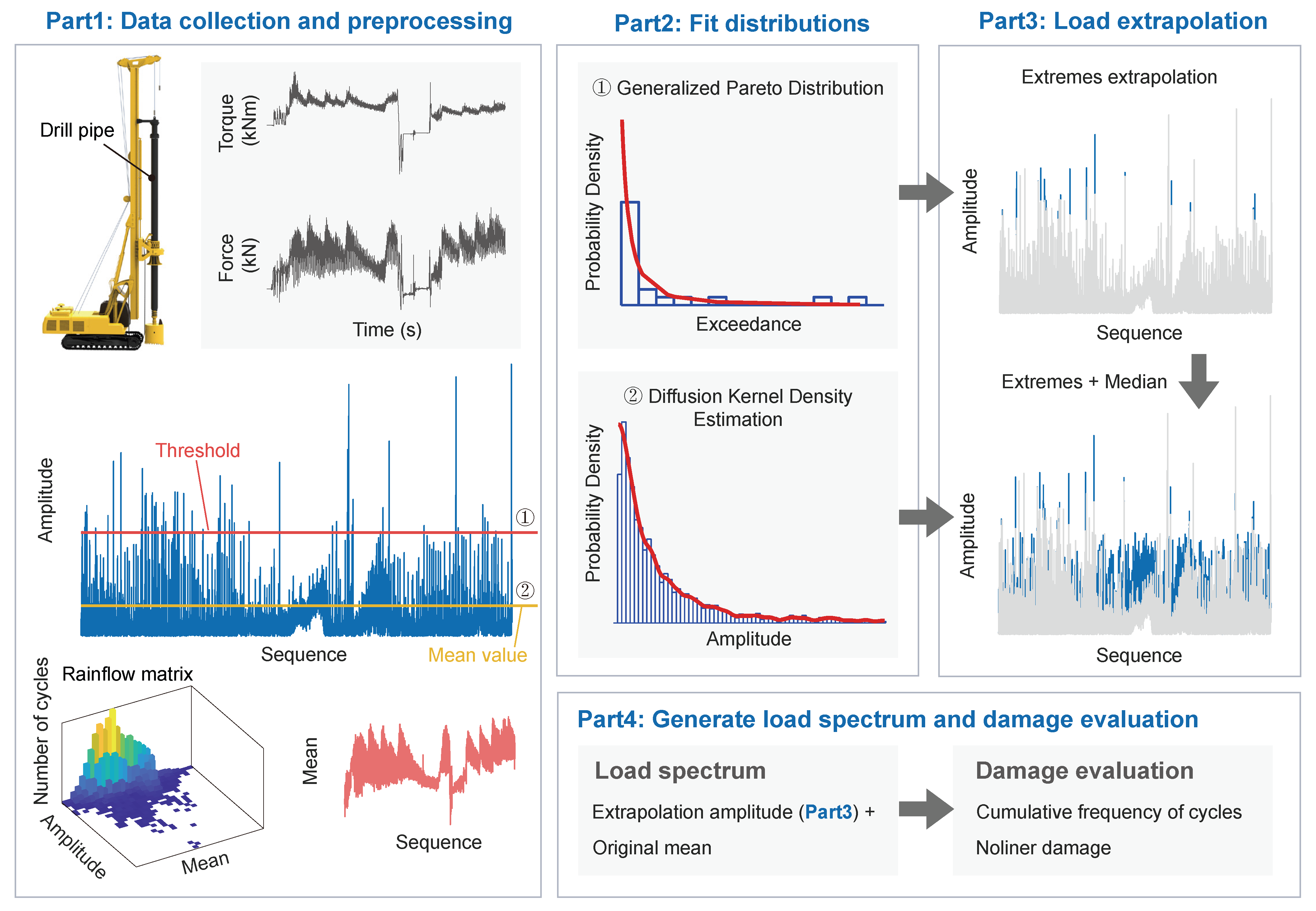
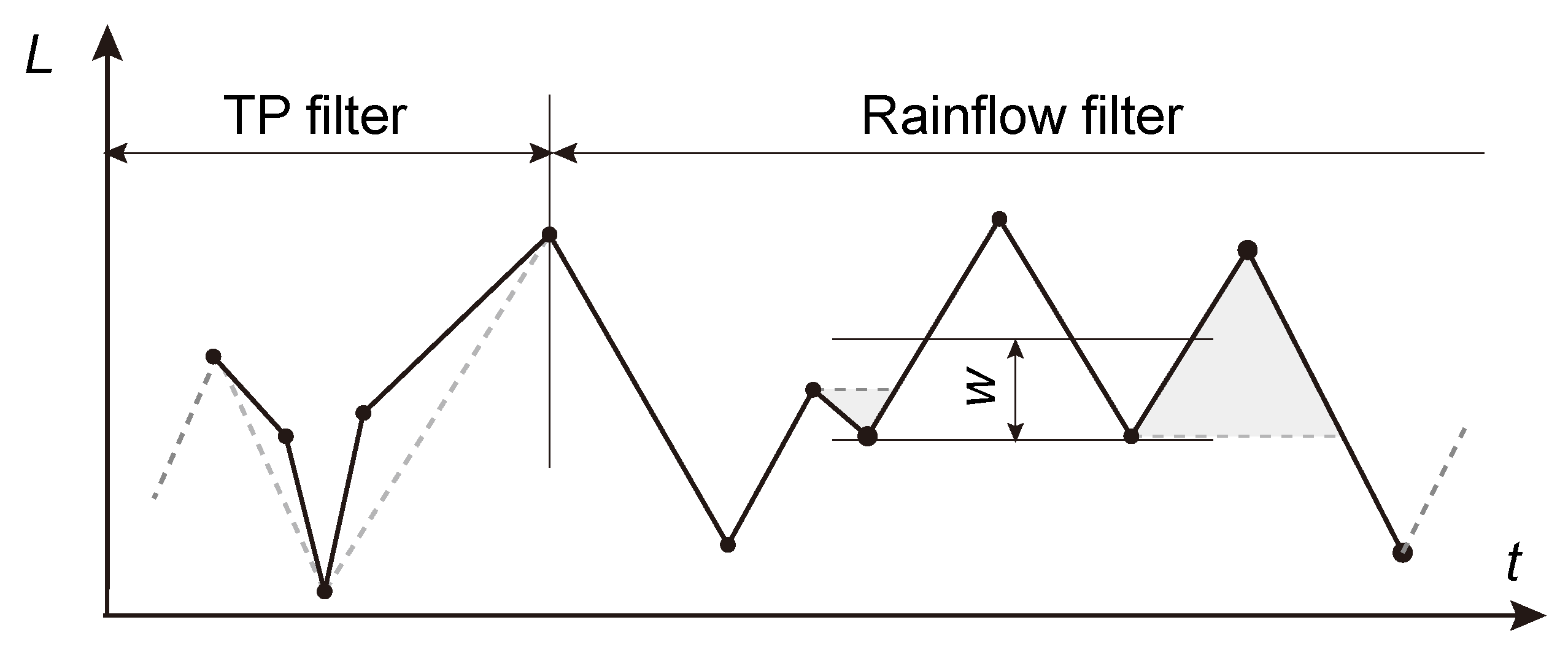

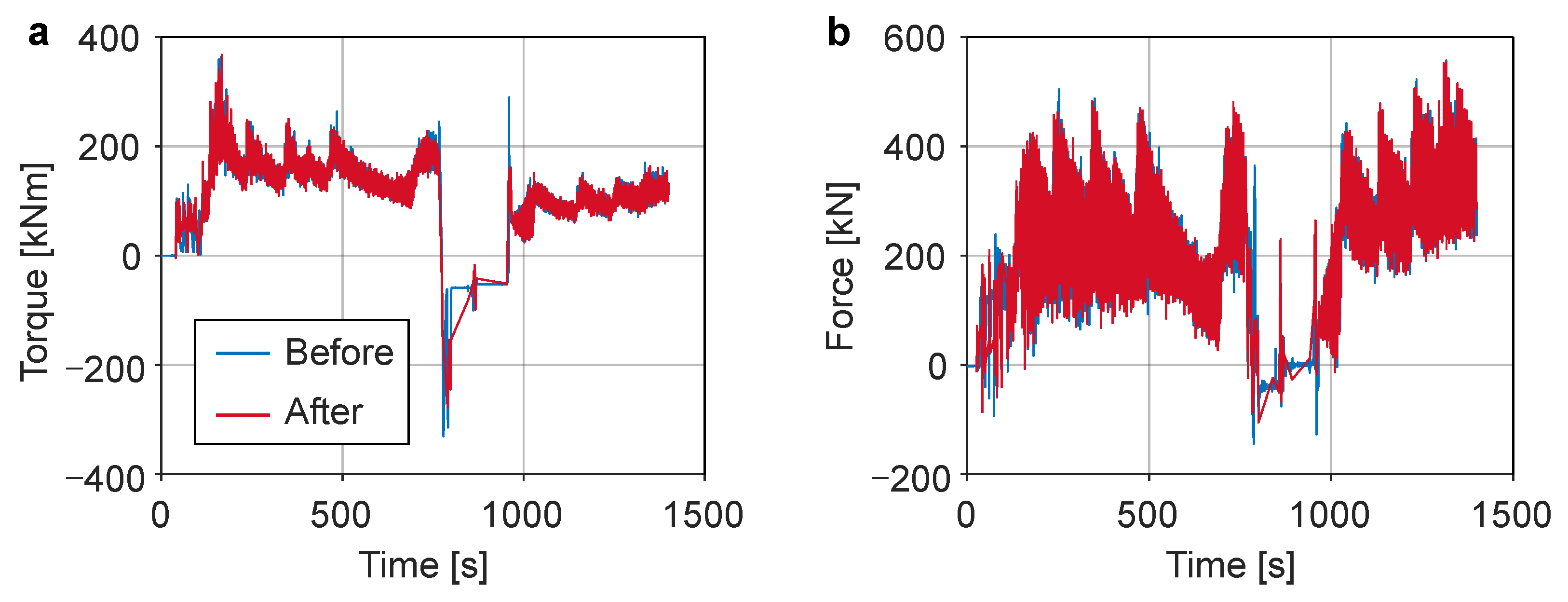
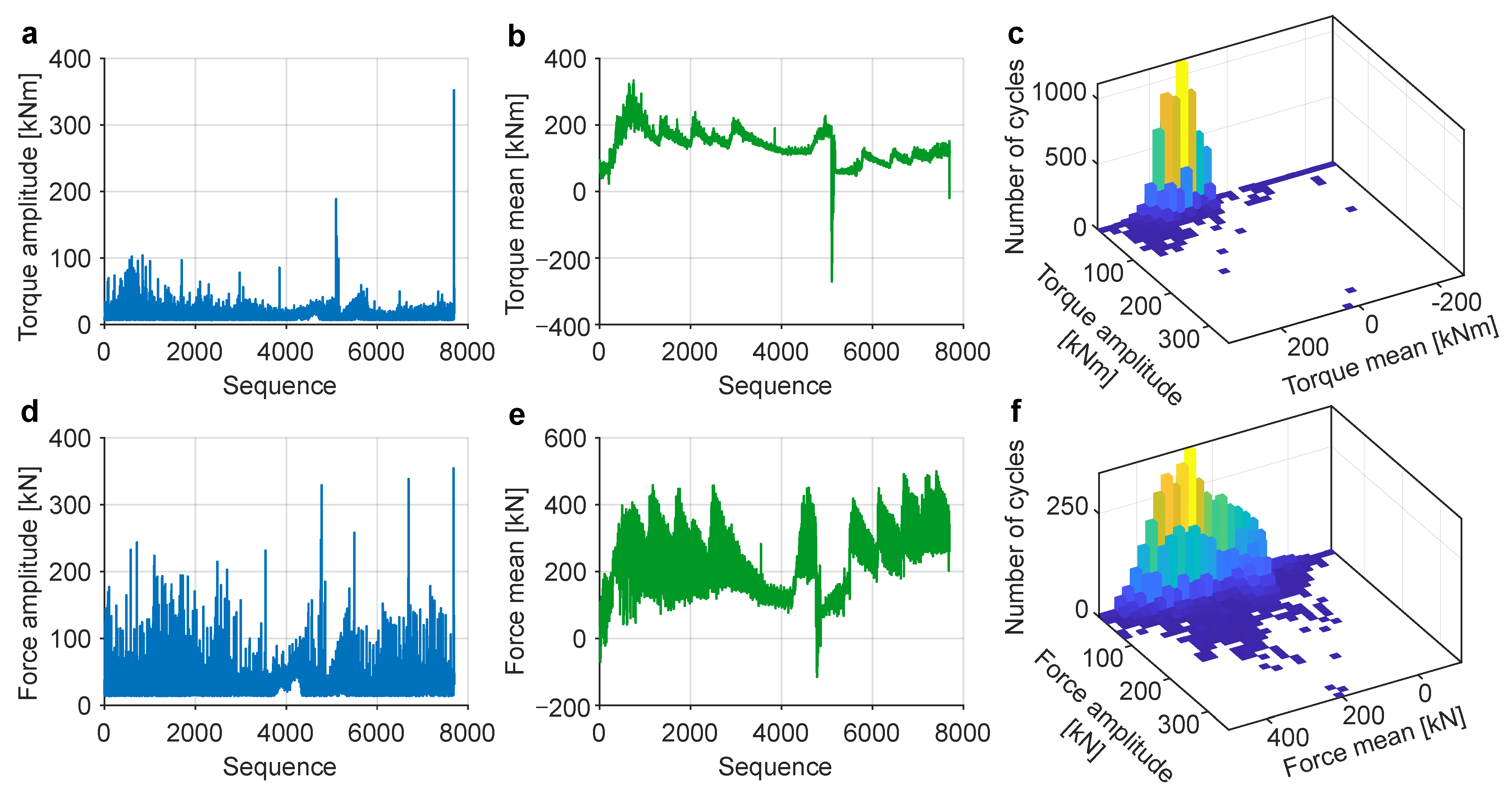
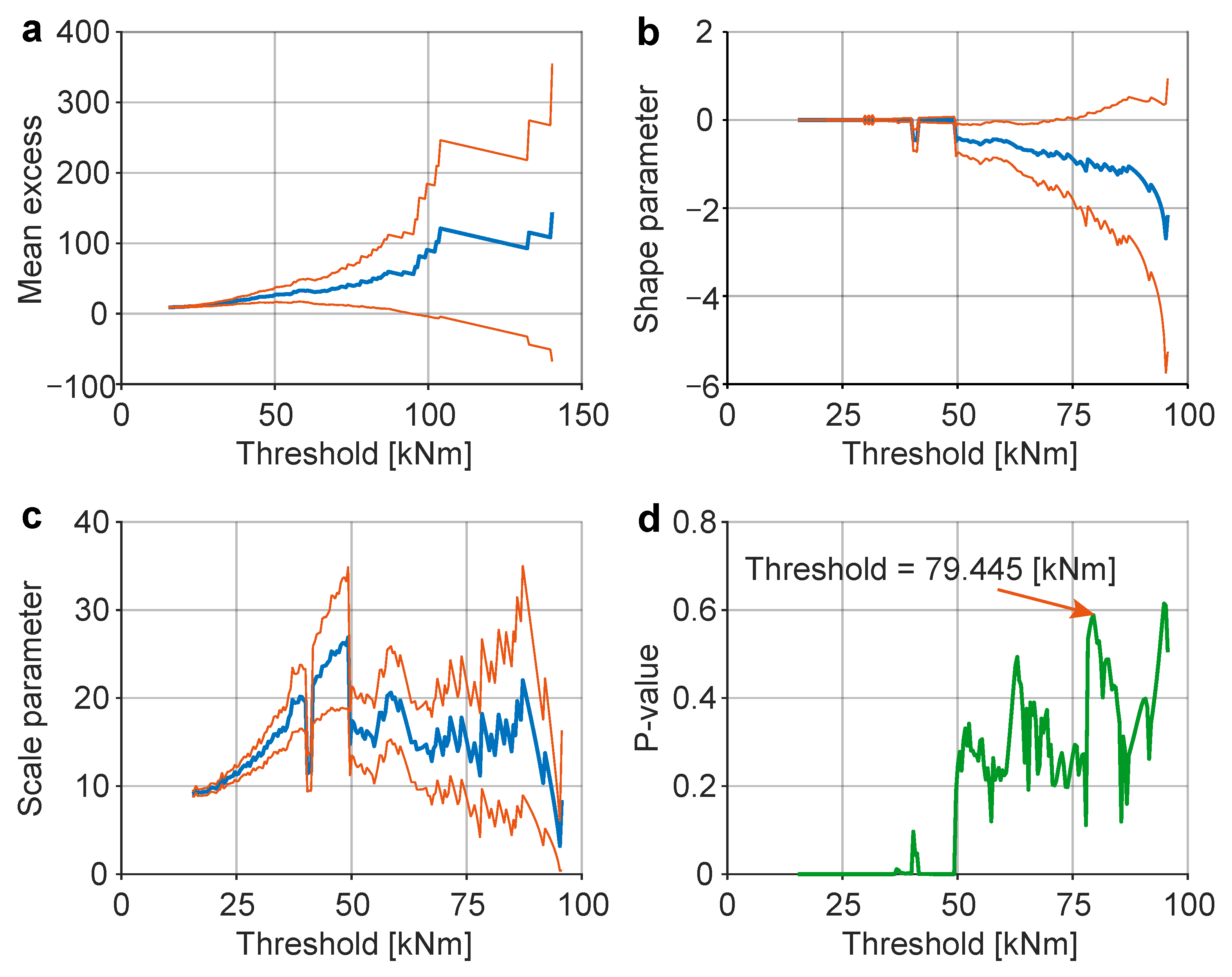
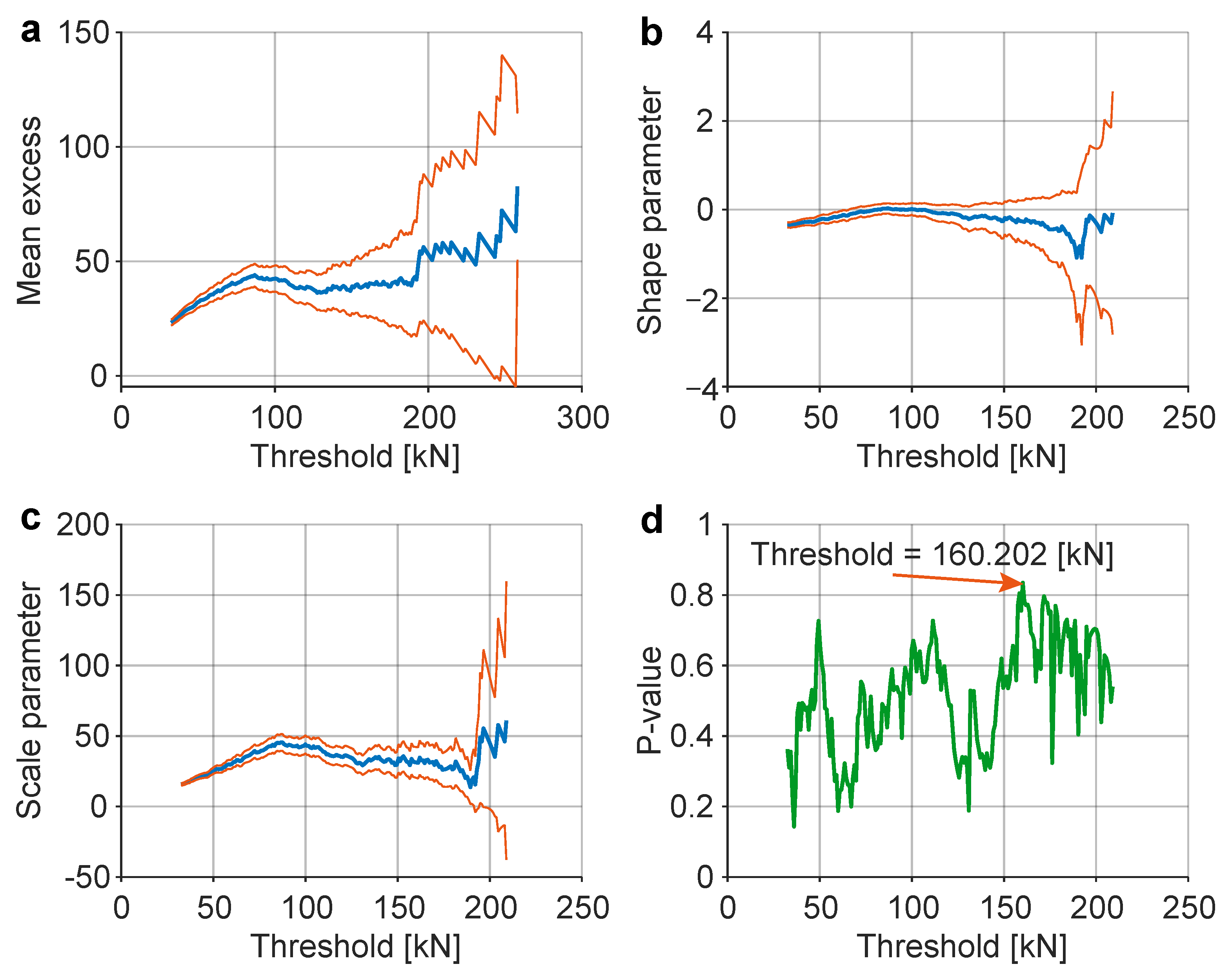
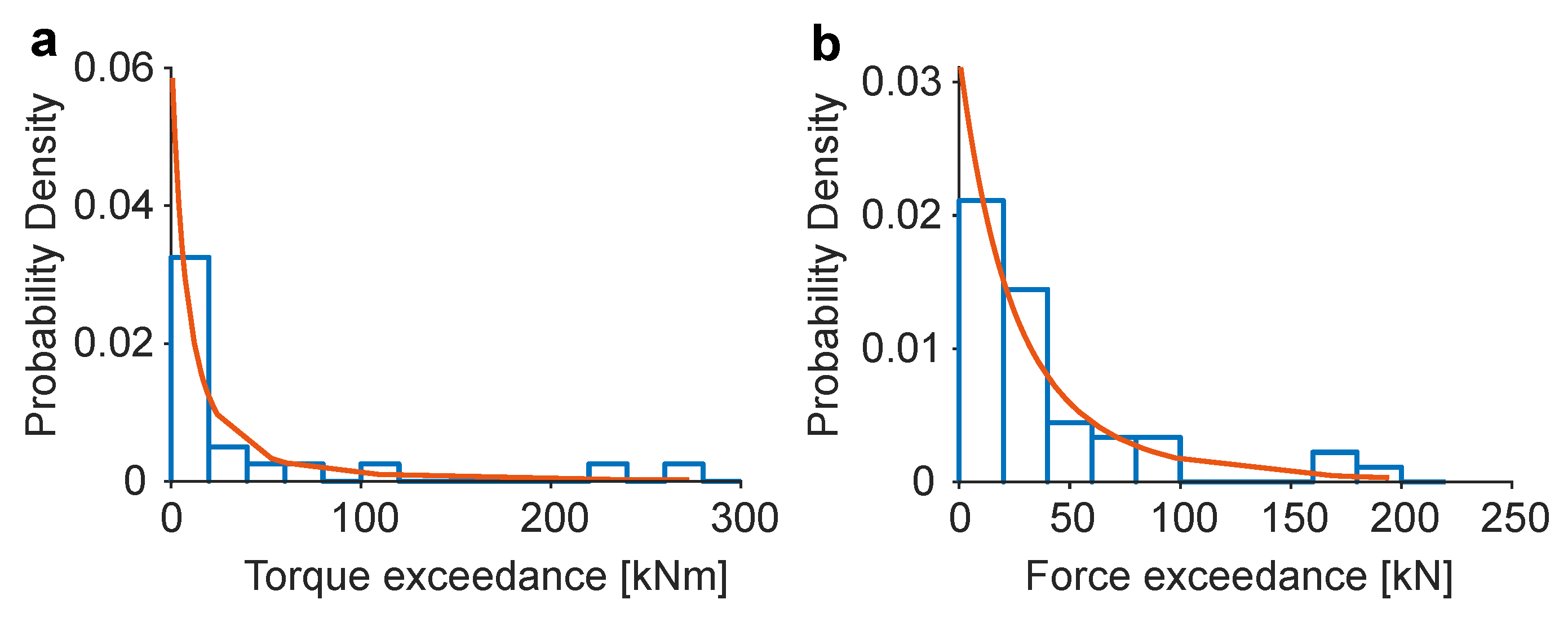



| Items | Shape Parameter | Scale Parameter | Threshold | p-Value | Number of Extremes |
|---|---|---|---|---|---|
| Torque amplitude | −1.005 | 15.409 | 79.445 kNm | 0.588 | 33 |
| Force amplitude | −0.269 | 31.233 | 160.202 kN | 0.835 | 45 |
| Items | Minimum Value | Maximum Value | Bandwidth | Goodness of Fit | Number of Median Values |
|---|---|---|---|---|---|
| Torque amplitude | 15.392 kNm | 79.445 kNm | 0.972 | 0.994 | 2706 |
| Force amplitude | 32.494 kN | 160.202 kN | 2.030 | 0.995 | 2371 |
| Items | Nonlinear Pseudo-Damage | Ratio |
|---|---|---|
| Original load | 1.00 | |
| Parametric extrapolation | 20.90 | |
| Liner extrapolation | 10.35 | |
| Proposed extrapolation | 12.59 |
Disclaimer/Publisher’s Note: The statements, opinions and data contained in all publications are solely those of the individual author(s) and contributor(s) and not of MDPI and/or the editor(s). MDPI and/or the editor(s) disclaim responsibility for any injury to people or property resulting from any ideas, methods, instructions or products referred to in the content. |
© 2024 by the authors. Licensee MDPI, Basel, Switzerland. This article is an open access article distributed under the terms and conditions of the Creative Commons Attribution (CC BY) license (https://creativecommons.org/licenses/by/4.0/).
Share and Cite
Wang, H.; Zhang, Z.; Zhang, J.; Shen, Y.; Wang, J. A Novel Load Extrapolation Method for Multiple Non-Stationary Loads on the Drill Pipe of a Rotary Rig. Machines 2024, 12, 75. https://doi.org/10.3390/machines12010075
Wang H, Zhang Z, Zhang J, Shen Y, Wang J. A Novel Load Extrapolation Method for Multiple Non-Stationary Loads on the Drill Pipe of a Rotary Rig. Machines. 2024; 12(1):75. https://doi.org/10.3390/machines12010075
Chicago/Turabian StyleWang, Haijin, Zonghai Zhang, Jiguang Zhang, Yuying Shen, and Jixin Wang. 2024. "A Novel Load Extrapolation Method for Multiple Non-Stationary Loads on the Drill Pipe of a Rotary Rig" Machines 12, no. 1: 75. https://doi.org/10.3390/machines12010075
APA StyleWang, H., Zhang, Z., Zhang, J., Shen, Y., & Wang, J. (2024). A Novel Load Extrapolation Method for Multiple Non-Stationary Loads on the Drill Pipe of a Rotary Rig. Machines, 12(1), 75. https://doi.org/10.3390/machines12010075





